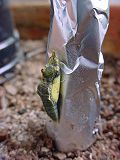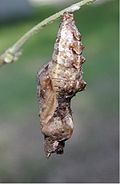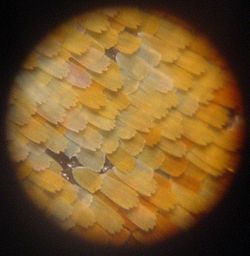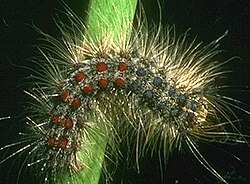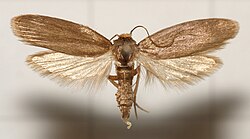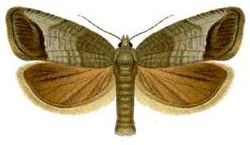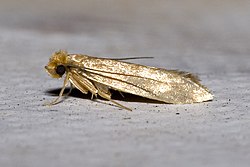Difference between revisions of "AY Honors/Moths & Butterflies"
Jomegat bot (talk | contribs) (Bot: Automated import of articles) |
|||
| Line 20: | Line 20: | ||
The most challenging requirement of this honor is probably this: | The most challenging requirement of this honor is probably this: | ||
| − | <b>{{reqreq|page={{PAGENAME}}|num= | + | <b>{{reqreq|page={{PAGENAME}}|num=7}}</b> |
</translate> | </translate> | ||
Revision as of 02:18, 26 December 2020
Overview
The Challenging Part
The most challenging requirement of this honor is probably this:
7. Identify in the field, then draw, photograph or collect 25 species of moths and butterflies, with not more than two specimens of any one variety. When collecting, specimens should be anesthetized by using carbon tetrachloride or other chemical in collecting jar. In either project correctly label and include the following information:
- a. Name
- b. Date observed
- c. Location
- d. Time of day
- e. Plant on which the insect was feeding or the material on which it was perched
[[AY Honors/Moths & Butterflies/Requirements|Tab Name/Printable Version]]
1. What is the distinction between moths and butterflies?
2. Define the following terms: antennae, cocoon, pupa, larva, chrysalis.
3. Be able to identify three moths and/or butterflies by their cocoons.
4. What causes colored powder to come off on your hands when you handle the wings of a butterfly or moth? Examine the powder of a butterfly or moth with a magnifying lens and describe your findings.
5. Name three harmful tree moths and one harmful house moth and tell during what stage of their lives they each do their damage.
6. What famous butterfly follows the birds southward every winter and comes northward in the spring?
7. Identify in the field, then draw, photograph or collect 25 species of moths and butterflies, with not more than two specimens of any one variety. When collecting, specimens should be anesthetized by using carbon tetrachloride or other chemical in collecting jar. In either project correctly label and include the following information:
- a. Name
- b. Date observed
- c. Location
- d. Time of day
- e. Plant on which the insect was feeding or the material on which it was perched
8. Describe the life cycle of a butterfly or moth. What lesson can be learned in connection with the resurrection of the righteous.
Printable Answer Key Tab Name/Edit Answer Key
1
The division of Lepidopterans into moths and butterflies is a popular taxonomy, not a scientific one. The distinctions listed here are not absolute. There are many butterflies with some of the characteristics of moths and many moths with some of the characteristics of butterflies.
Antennae
The most obvious difference is in the feelers, or antennae. Most butterflies have thin slender filamentous antennae which are club shaped at the end. Moths, on the other hand, often have comb-like or feathery antennae, or filamentous and unclubbed.
Pupae
Most moth caterpillars spin a cocoon made of silk within which they metamorphose into the pupal stage. Most butterflies on the other hand form an exposed pupa which is also termed as a chrysalis.
Coloration of the wings
Most butterflies have bright colours on their wings. Nocturnal moths on the other hand are usually plain brown, grey, white or black and often with obscuring patterns of zigzags or swirls which help camouflage them as they rest during the day. However many day-flying moths are brightly-colored, particularly if they are toxic. A few butterflies are also plain-colored, like the Cabbage White butterfly.
Time of activity
Most moths are nocturnal while most butterflies are diurnal. There are however exceptions, including the diurnal Gypsy moth and the spectacular "Uraniidae" or Sunset moths.
Resting posture
Moths usually rest with their wings spread out to their sides. Butterflies frequently fold their wings above their backs when they are perched although they will occasionally "bask" with their wings spread for short periods.
2
- Antennae
- Antennae are paired appendages connected to the front-most segments of an insect. Antennae are jointed, at least at the base, and generally extend forward from the head. They are sensory organs, although the exact nature of what they sense and how they sense it is not the same in all groups, nor always clear. Functions may variously include sensing touch, air motion, heat, vibration (sound), and especially smell or taste.
- Cocoon
- A cocoon is a casing spun of silk by many moth caterpillars and numerous other insect larvae as a protective covering for the pupa.
- Pupa
- A pupa is the life stage of some insects undergoing transformation.
- Larva
- A larva is a juvenile form of animal with indirect development, undergoing metamorphosis (for example, insects or amphibians). The larva can look completely different from the adult form, for example, a caterpillar differs from a butterfly. Larvae often have special (larval) organs which do not occur in the adult form.
- Chrysalis
- A chrysalis or nympha is the pupal stage of butterflies. Because chrysalids are often showy and are formed in the open they are the most familiar examples of pupae. Most chrysalids are attached to a surface by a Velcro-like arrangement of a silken pad spun by the caterpillar and a set of hooks at the tip of the pupal abdomen.
3
4
This powder is made from tiny scales which cover the butterfly's wings. These scales give the wings their color, as the membrane beneath the scales is nearly transparent. The scales detach when abraded by a finger, much as the skin on a person's knee is abraded when it contacts a sidewalk.
5
Tree Moths
Gypsy Moth
The gypsy moth was introduced into the United States in 1868 by a French scientist, Leopold Trouvelot, living in New Bedford, Massachusetts. The native silk spinning caterpillars were proving to be susceptible to disease. So Trouvelot brought over gypsy moth eggs to try to make a caterpillar hybrid, that could resist diseases. When some of the moths escaped from his lab, they started to multiply. They eventually grew to be gypsy moths as we know them today. It is now one of the most notorious pests of hardwood trees in the Eastern United States.
Since 1980, the gypsy moth has defoliated over 1,000,000 acres (4,000 km²) of forest each year. In 1981, a record 12,900,000 acres (52,200 km²) were defoliated. This is an area larger than Rhode Island, Massachusetts, and Connecticut combined. In wooded suburban areas, during periods of infestation when trees are visibly defoliated, gypsy moth larvae crawl up and down walls, across roads, over outdoor furniture, and even inside homes. During periods of feeding they leave behind a mixture of small pieces of leaves and frass, or excrement. During outbreaks, the sound of chewing and frass dropping is a continual annoyance. Gypsy moth populations usually remain at very low levels but occasionally populations increase to very high levels which can result in partial to total defoliation of host trees for 1-3 years.
Gypsy moths eat only during their larval stage.
Tent caterpillar
"Tent Caterpillars" are moderately sized species in the genus Malacosoma in the moth family Lasiocampidae. Species occur in North America and Eurasia. Twenty-six species have been described, six of which occur in North America. Although most people consider tent caterpillars only as pests due to their habit of defoliating trees, they are among the most social of all caterpillars and exhibit many noteworthy behaviors.
Tent caterpillars are readily recognized because they are social, colorful, diurnal and build conspicuous silk tents in the branches of host trees. Some species, such as the eastern tent caterpillar, Malacosoma americanum, build a single large tent which is typically occupied through the whole of the larval stage while others build a series of small tents that are sequentially abandoned. The forest tent caterpillar, Malacosoma disstrium, is exceptional in that the larvae build no tent at all, aggregating instead on silken mats that they spin on the leaves or bark of trees. Tents facilitate aggregation and serve as focal sites of thermal regulatory behavior. They also serve as communication centers where caterpillars are alerted to the discovery of new food finds.
Lesser wax moth
Wax moths were first seen in North America in 1806. People believe they came over with honeybees from Europe. The lesser wax moth is very common all over the world, except the colder regions. The larvae are the only ones that eat, the adults will not eat.
Their diet typically consists of honey, beeswax, stored pollen, bee shell casings, and, in some cases, bee brood. While tunneling through honeycombs attaining food, these moths are also protecting themselves from their main enemy, the honeybee.
Codling moth
Codling moths are known as an agricultural pest, their larva being the common apple worm or maggot. It is native to Europe and was introduced to North America, where it has become one of the regular pests of apple orchards. It is found almost worldwide. It also attacks pears, walnuts, and other tree fruits. This larva is the famous "worm in the apple" of cartoon and vernacular fame.
House Moths
Clothing Moth
The Clothing Moth (Tineola bisselliella) is a winged insect capable of flying, which develops from a caterpillar. It is recognized as a serious pest. Like most moth caterpillars, it can (and will) derive nourishment not only from clothing but also from many other sources.
Eggs hatch into larvae, which then begin to feed. Once they get their fill, they pupate and undergo metamorphosis to emerge as adults. Adults do not eat: male adults look for females and adult females look for places to lay eggs. Once their job is done, they die. Contrary to what most people believe, adult clothing moths do not eat or cause any damage to clothing or fabric. It is the larvae which are solely responsible for this, spending their entire time eating and foraging for food.
White-shouldered Moth
The White Shouldered House Moth (Endrosis sarcitrella) is a very common moth and occurs regularly inside buildings, and being continuously-brooded, can be found at any time of year, mainly found indoors via open doors, windows etc. It is a widely distributed species whose larvae infest stored grain
6
Monarch butterflies are especially noted for their lengthy annual migration. They make massive southward migrations starting in August until the first frost. A northward migration takes place in the spring. Female Monarchs deposit eggs for the next generation during these migrations. By the end of October, they reach their overwintering grounds. The length of these journeys exceeds the normal lifespan of most Monarchs, which is less than two months for butterflies born in early summer. The last generation of the summer enters into a non-reproductive phase known as diapause and may live up to 7 months. During diapause, butterflies fly to one of many overwintering sites. The generation that overwinters generally does not reproduce until it leaves the overwintering site sometime in February and March. It is thought that the overwinter population may reach as far north as Texas and Oklahoma during the spring migration. It is the second, third and fourth generations that return to their northern locations in the United States and Canada in the spring. How the species manages to return to the same overwintering spots over a gap of several generations is still a subject of research; the flight patterns appear to be inherited, based on a combination of circadian rhythm and the position of the sun in the sky.
7
- a. Name
- b. Date observed
- c. Location
- d. Time of day
- e. Plant on which the insect was feeding or the material on which it was perched
For identification purposes, you will need to get a copy of a good field guide. As with many other identification tasks, it is best to find a specimen first and then attempt to identify it, rather than going out to look for a particular specimen.
Pathfinders are encouraged to draw or photograph specimens rather than collect them. Identification should be done in the field. If going as a group, it is OK to bring one camera (perhaps the instructor's) and then have the rest of the participants make their drawing from the pictures taken. If you have access to a digital camera and a projector, you could project a slide show and have the Pathfinders make drawings as the slides are shown. You may also print the photos and pass them around.
for identifying them online here are some, http://www.insectidentification.org/butterflies-and-moths.asp
8
Butterflies and moths are notable for their unusual life cycle with a larval caterpillar stage, an inactive pupal stage, and a spectacular metamorphosis into a familiar and colorful winged adult form.
Life Cycle
Unlike many insects, butterflies do not experience a nymph period, but instead go through a pupal stage which lies between the larva and the adult stage. The four stages of a butterfly's life cycle are:
- Egg
- Butterfly eggs are fixed to a leaf with a special glue which hardens rapidly. As it hardens it contracts, deforming the shape of the egg. This glue is easily seen surrounding the base of every egg. Eggs are usually laid on plants. Each species of butterfly has its own hostplant range and while some species of butterfly are restricted to just one species of plant, others use a range of plant species, often including members of a common family.
- Caterpillar
- Larvae, or caterpillars, are multi-legged eating machines. They consume plant leaves and spend practically all of their time in search of food. Caterpillars mature through a series of stages, called instars. At the end of each instar, the larva moults the old cuticle, and the new cuticle rapidly hardens and pigments. Development of butterfly wing patterns begins by the last larval instar.
- Pupa
- When the larva is fully grown, hormones are produced. At this point the larva stops feeding and begins "wandering" in the quest of a suitable pupation site, often the underside of a leaf. The larva transforms into a pupa (or chrysalis) by anchoring itself to a substrate and moulting for the last time. The chrysalis is usually incapable of movement, although some species can rapidly move the abdominal segments or produce sounds to scare potential predators.
- Imago
- The adult, sexually mature, stage of the insect is known as the imago. After it emerges from its pupal stage, a butterfly cannot fly until the wings are unfolded. A newly-emerged butterfly needs to spend some time inflating its wings with blood and letting them dry, during which time it is extremely vulnerable to predators. Some butterflies' wings may take up to three hours to dry while others take about one hour.
Resurrection
The life cycle of the butterfly has parallels to the life cycle of a Christian. During the larval stage, a butterfly lacks the beauty of an adult. It spends all of its time feeding itself, often causing major damage to plants. This stage of a butterfly's life can be likened to the untranslated state of man, in that it is unlovely and often ignorant of the damage it causes.
Eventually, the caterpillar pupates. This stage is parallel to death.
While inside its chrysalis, the butterfly is transformed. This is not something it is conscious of doing. At the resurrection of the righteous, the Christian will also transformed by Christ into a new person, free from all defects. Gone are the selfish desires and the ugliness. It is a beautiful creature free from sin.
References
New and Used Field Guides at Amazon
Content on this wiki is generated by people like you, and no one has created a lesson plan for this honor yet. You could do that and make the world a better place.
See AY Honors/Model Lesson Plan if you need ideas for creating one.

